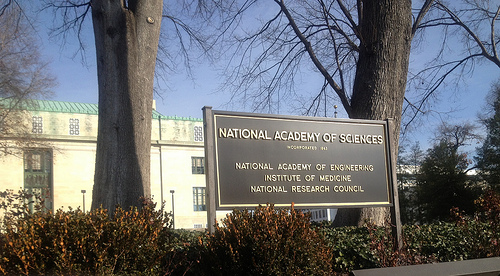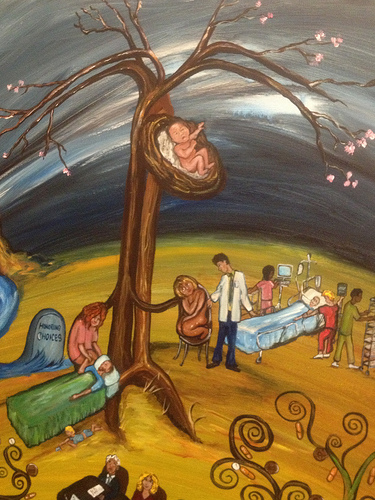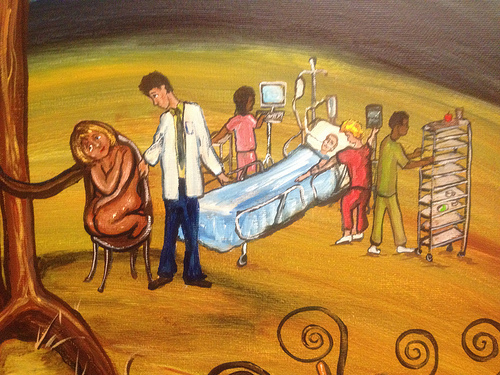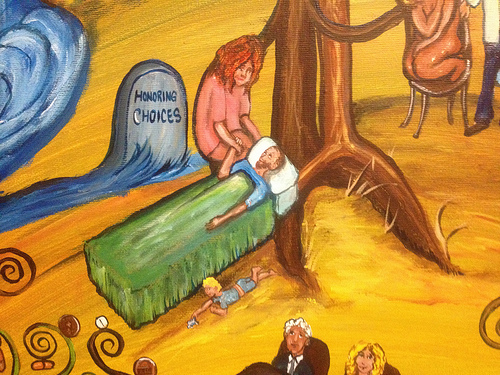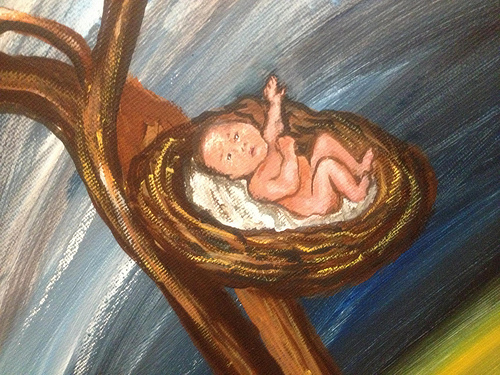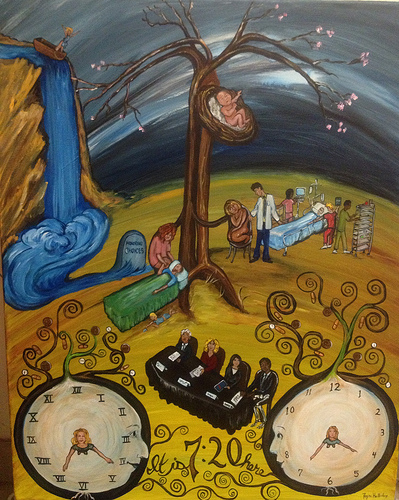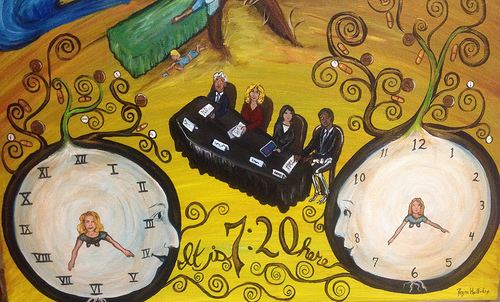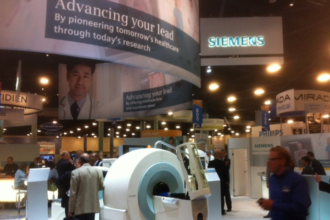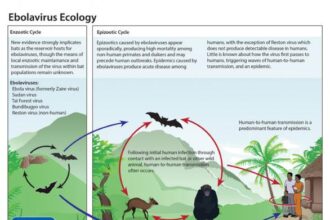Yesterday, I painted with a class of second graders. They were little bundles of captured energy. Their eyes sparkled and they could not be quiet. The majority of the class finished the project early and a detail oriented few painstakingly completed theirs. So I offered to tell the restless ones a story. It was a classic tale of mirrors, apples and coffins made of glass. I finished in the customary way. Their voices joined mine in the refrain, “They lived happily ever after.”
Life may be filled with great happiness; but often holds an equal measure of sorrow. Life becomes a story, and every story ends.
On Tuesday January 29th-Wednesday January 30th, I attended C-TAC (Coalition to Transform Advanced Care) National Summit on AdvancedCare in Washington, DC. The meeting was held at the Institute of Medicine National Academy of Sciences building at 2101 Constitution Avenue. The building is a lovely Art Nouveau edifice. The foyer and the marble hall are bedecked with stunning mosaics, carefully maintained murals and early 20thcentury woodwork. The remodeled auditorium is a modern, almost clinical design juxtaposed against the rich warm texture of the rest of the building. I thought it the perfect venue for our topic of conversation.
When I arrived, I asked where I could set up my easel and paints. The C-TAC volunteers looked concerned. Although, I had been invited to attend and exchanged emails with the event planner, they had forgotten this detail. My friends Ted Eytanhttps://twitter.com/tedeytan and Alex Drane assisted me in finding someone who could determine an appropriate place to paint. Soon we were talking to one of the facility directors. She looked worried and said she would have to clear this request.
The conference day was well underway by the time I began to paint and tweet. The topic of the conference was advanced illness care. “Advanced Care” is a new euphemism for “End of Life,” which really confused me at first, because I thought it was some kind of gifted and talented version of healthcare. As a child who struggled through grade school, AP classes were always out of reach. I did mange to be in some honors classes though. Honor courses encouraged deep insight, rather than high scores.
At 9:30 am the panel presentations began with “Care Journey: Personal Reflections on Advanced Care.”
Amanda Bennett from Bloomberg News told us about her husband’s 7 years battling kidney cancer. I listened intrigued. Our family only had 3 months after the diagnosis of my husband Fred’s kidney cancer. I began to paint with our stories entwined.
I painted the two kidneys, the inferior vena cava and the descending aorta as two trees in winter; a tree of life and a tree of knowledge reminding us of a bargain struck so long ago. To the right I painted Amanda’s experience with her husband’s sickness and death. He died experiencing over-treatment, with blood draws and tests until the end. I painted Amanda retreating within her visitor’s chair, completely nude and vulnerable as the machine of medicine chewed upon their life. A resident stands hesitatingly preparing to tell her the end will come soon.
To the left our family story unfolds.
Fred spent two months on the roller coaster of curative care and one month in the blessed embrace of hospice care. He lies upon his bed as we gaze at each other. Our three-year-old son Isaac plays with a toy train beside his Father’s deathbed.
Above within the branches of the tree, a nest is perched where the heart resides. Within the nest a newborn babe searches for the eyes he can trust, the eyes that see the soul. As Brad Stuart fromSutter Care at Home reminded the crowd. We end as we begin, our eyes searching for the ones we love.
I spent the lunch hour painting as folks looked over with curious stares. One lovely young woman came over to tell me she worked in Health Information Technology and was so glad to see someone she recognized from the world of HIT at this event. I said I understood and wished that were more of us with attending meetings in HIT, End of Life and Patient Safety.
Soon I left for to pick up Isaac from school and returned on Wednesday for day two.
Our first keynote speaker was Kathy Greenlee, Assistant Secretary for Aging and Administrator for Community Living US Dept. of Health and Human Services. She spoke about the work of her office and encouraged all in attendance to come by and meet with her about this important topic.
Our first keynote speaker was Kathy Greenlee, Assistant Secretary for Aging and Administrator for Community Living US Dept. of Health and Human Services. She spoke about the work of her office and encouraged all in attendance to come by and meet with her about this important topic.
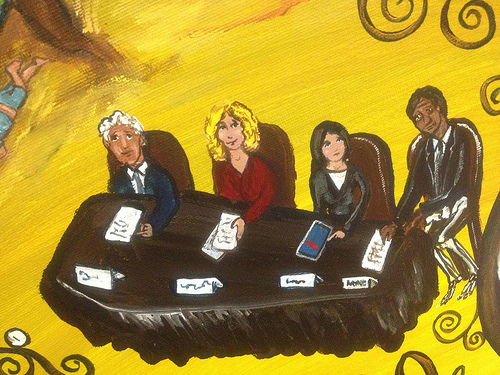 Wednesday’s first panel was entitled “Empowering the Public to Make Informed Decisions and Plans” Alex Drane was the moderator. By this point I had seen several panel presentations with speakers seated at a black fabric covered table and each keynote speaker was peering over a colossal podium. I was getting frustrated that we were only seeing half of their bodies and often half of the energy of a speaker without such physical shields.
Wednesday’s first panel was entitled “Empowering the Public to Make Informed Decisions and Plans” Alex Drane was the moderator. By this point I had seen several panel presentations with speakers seated at a black fabric covered table and each keynote speaker was peering over a colossal podium. I was getting frustrated that we were only seeing half of their bodies and often half of the energy of a speaker without such physical shields. TED and TEDMED have figured this out; we bare our soul when we speak with our whole bodies. A seated speaker is only telling half of the story. Then I began to wonder if this presentation choice was not some grand metaphor. For this was a conference about end of life but rarely did I here the word death mentioned. So on the barren field I painted a seated panel. Their covered table is a coffin. Most of the speakers exist as a torso above the covered table, but the angle is such that the last speaker to the right reveals his lower body is a skeleton. Our surface discussion may not contain the word death but it lingers beneath.
As I stared upon this panel, Alex Drane told us a lovely story from that morning. Her daughter had discovered that Alex has a cell phone that she will always answer. Her daughter called her and after a pause asked, “What time is it where you are?” Like many of us who speak about the future of healthcare Alex flies across the nation empowering others. Hours as well as miles often divide her family.
Alex smiled and said, “It is 7:20 here.” There was silence on the line as her daughter did some quick mental math. Soon she responded with a joyful voice, “It is 7:20 here too!”
This painting has a name: “It is 7:20 here.”
And it is.
We are living in this moment and there is no better time to talk about our wishes with the ones we love.
So in the foreground of this piece two clock faces look upon each other. Each says 7:20 and the hands that depict the time are the hands of Alex and her daughter. The clocks also represent the stylized bulb of an onion. For as Alex’s daughter could surely tell you “Onions have layers” as does our conversation of this day.
So in the spooling circles above our clock faces there are pennies.
For throughout this conversation about the care of those we love there is a thread shines like the sheen of money. Did you know it now costs more to make a penny than what a penny is worth? And so it goes at the end of life, when often a life is extended not for the benefit of the patient but for the pocket of another.
Within the twinning branches pills have become leaves like a pharmaceutical Klimt piece. The copper pills are the Sutent that extended Amanda’s husband’s life and sit within a shadow box in mine.
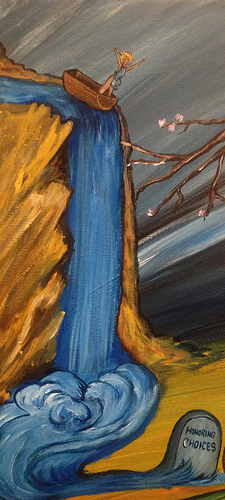 Soon beautiful Amy Berman (nurse and Senior Program Manager at the Hartford Foundation) began to speak, her hair a golden halo. Her face serene as she told us she lived under a death sentence. She has stage four inflammatory breast cancer. This type spreads quickly throughout the body. When Amy noticed it, it looked just like an inflamed patch upon her skin. But it had already spread throughout her body. She was stage four and there is no successful treatment available. Her oncologist began to explain an incredibly aggressive course. There would be a mastectomy; chemotherapy, radiation and they would fight for every hour of her extended life. She looked at the doctor and enquired, “Why a mastectomy when the cancer has already spread?” He looked at her nonplussed and replied, “You don’t want to look at it do you?”
Soon beautiful Amy Berman (nurse and Senior Program Manager at the Hartford Foundation) began to speak, her hair a golden halo. Her face serene as she told us she lived under a death sentence. She has stage four inflammatory breast cancer. This type spreads quickly throughout the body. When Amy noticed it, it looked just like an inflamed patch upon her skin. But it had already spread throughout her body. She was stage four and there is no successful treatment available. Her oncologist began to explain an incredibly aggressive course. There would be a mastectomy; chemotherapy, radiation and they would fight for every hour of her extended life. She looked at the doctor and enquired, “Why a mastectomy when the cancer has already spread?” He looked at her nonplussed and replied, “You don’t want to look at it do you?”Amy could not believe it. He was recommending cosmetic oncology.
He further added this was the course of treatment he would recommend to any of his patients. But Amy was not “anybody” and she did not want cookie cutter recommendations or a life that was lived in more pain than was necessary. Amy wanted to live to her fullest and then wanted a Niagara Falls. In end stage cancer, patients make a choice. They can choose aggressive care and plummet down a step vertical and then float on a horizontal of lingering pain before death. Or then can live life on the fast-paced stream without added nausea and pain until they plunge down at once as the end nears.
He further added this was the course of treatment he would recommend to any of his patients. But Amy was not “anybody” and she did not want cookie cutter recommendations or a life that was lived in more pain than was necessary. Amy wanted to live to her fullest and then wanted a Niagara Falls. In end stage cancer, patients make a choice. They can choose aggressive care and plummet down a step vertical and then float on a horizontal of lingering pain before death. Or then can live life on the fast-paced stream without added nausea and pain until they plunge down at once as the end nears.
I painted Amy in her Niagara Falls moment as the wind whips her patient gown around her body. Her stance is sure within her half-barrel and her face upraised to greet her choice with open arms. As I painted it thus, one attendee said, “I thought the barrels used at Niagara were full barrels.” I responded, “Full barrels are used by those who think they might survive the fall.”
Soon Bill Hanley from Twin Cities Public Radio spoke. He followed Kent Wilson from Honoring Choices Minnesota. They both spoke of the amazing program Honoring Choices and the teachable moments that arrive when PBS works hand in hand with hospitals to create a safe place for conversations about end of life. This is my second time to see them speak and I represented their great work with a tombstone beside our heart tree.
That should have been the end of the panel, but Alex had offered me two minutes to speak. I have never spoken before about a painting that was only half-finished, but perhaps that was perfect time to speak about this painting. It continues the metaphor of the half-told tale. We will never make the strides we need to make in end of life care until we value the end like we value the beginning; until we see hospice cards in the Hallmark isle as much as we see cards that welcome new babies.
I told them that the painting was inspired by the twinning of Amanda Bennett’s story and my own. She suffered so, as did her husband with no time to say goodbye. We had the better death at home with friends and family. My husband and I spoke all night the night before he died back when I thought terminal restlessness was just a Tom Hanks film.
I painted for the rest of the day with people coming over often to chat. One was Amy. We hugged and laughed because we were wearing almost identical outfits! As she said we were sisters from another mother.
Soon we broke into sessions. I went to the Interfaith Workgroup on Spirituality. They are looking for suggestions on how to move things forward. I volunteered the power of the twitterverse to help the cause. So feel free to join the conversation!
That supper, with no prompting from me, my seven-year-old son Isaac told me he wants the Star Wars Imperial March to play at his funeral. He also wants a graveside service.
I responded, “I want to donate my body to science and then that is usually followed by cremation. So I won’t have a grave.” His eyebrows rose and he said, “You don’t want a tombstone?” I responded, “Nope.” He replied “Well, there will be no crayon rubbings of your tombstone then.” And proceeded to eat his macaroni.
Now, was that so hard?

